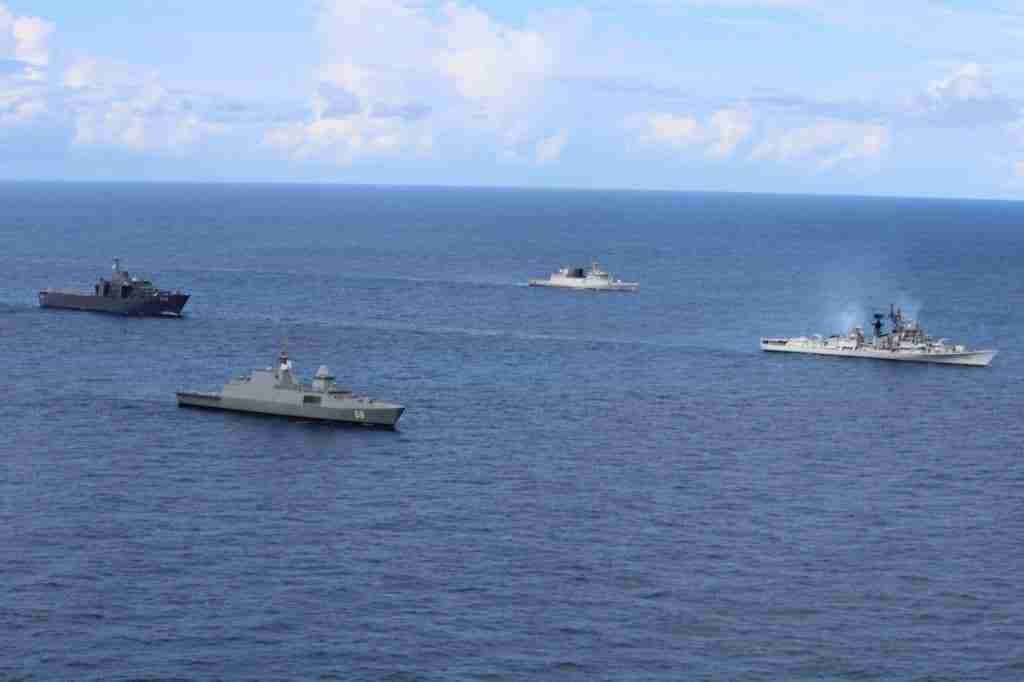The naval exercise ‘Malabar’ commenced as a bilateral Indo-US maritime exercise in 1992, and in 2015 saw the inclusion of Japanese Maritime Self defence Force (JMSDF). This year, the participation of Royal Australian Navy in Malabar-2020 had China admonishing Australia for its participation as a QUAD nation. The Chinese concern here has been the growing QUAD strength in the Indo-Pacific region. Also, China has emerged as a highly aggressive nation as India saw in the recent Sino-India border dispute which led to the lives of Indian soldiers being lost due to an unexpected direct confrontation.
Such Naval exercises provide an opportunity to synergise military drills and procedures while jointly undertaking naval tasks.
The ongoing military level border talks are unlikely to resolve the long standing dispute regarding LAC with China. Chinese policy of military muscle flexing when it comes to the territorial disputes like Sino-India land border or the South China Sea (SCS) has been of concern to the global powers and various bilateral and trilateral commercial and military agreements have been put in place to check China’s overbearing status in the region.
Post Malabar-2020, the Indian Navy also undertook a trilateral maritime exercise, SITMEX-20, with Singapore and Thailand on 21 and 22 November and a bilateral exercise, SIMBEX-20, with Singapore from 23-25 November.
Joint naval exercises
Joint maritime exercises with multinational naval forces are undertaken by nations with a common objective like maintaining peace or commercial growth in a region. Such exercises provide an opportunity to synergise military drills and procedures while jointly undertaking naval tasks. Naval warships have always been an instrument of power projection, and participation of a regional naval flotilla enhances the geo-political relationships in the region.
During these naval exercises at sea, the warships, submarines and aircrafts are tested for their peak performance levels of onboard weapons and sensors. Further, this also validates the equipment maintenance standards and training imparted to the manpower manning these systems.
The integration of multinational forces deployed by nations speaking diverse languages, carrying varied weaponry of choice and possessing an independent Standard Operating Procedures (SOPs) is a challenge. To overcome this, NATO forces follow a Common Standard Protocol, so as to be able to implement Joint Operational Doctrines for a cooperative engagement.
During these naval exercises at sea, the warships, submarines and aircrafts are tested for their peak performance levels of onboard weapons and sensors. Further, this also validates the equipment maintenance standards and training imparted to the manpower manning these systems. Multiple underlying technological concepts like interoperability, availability of real time information to form a Common Operational Picture (COP) are essential elements to execute warfare tactics.
The first level of synergy amongst the naval war fighting units is built using collation of ISR (Intelligence, Surveillance and Reconnaissance) statistics to undertake the combat planning at Fleet level. The overall threat perception is presented to the Flagship for his decision for a Fleet-level weapon allocation. This common battle-space awareness ensures earmarking of weapon engagement zones to maximise probability of target annihilation.
Exercise Malabar
Exercise Malabar was conducted in two phases on either side of the Indian peninsula, with Phase I in the Bay of Bengal near Visakhapatnam and Phase II in the Arabian Sea. Accordingly, Indian Navy’s Eastern and Western fleets participated separately in the exercise in each phase.
Keeping in view the growing Chinese threat in the Indo-Pacific, recently U.S. Navy Secretary has announced the intent of creating a new fleet within the Indo-Pacific theatre.
Similarly, US 7th Fleet ships were present in the first phase, followed by US 5th Fleet representation on the West coast since the global US Naval Fleet has been assigned Areas of Operations(AOO) as per geographical distribution which was demarcated under a Unified Command Plan consequent to the 9/11 incident in 2001.
Keeping in view the growing Chinese threat in the Indo-Pacific, recently U.S. Navy Secretary has announced the intent of creating a new fleet within the Indo-Pacific theatre. The focus of the warships in this Fleet shall be the southwest Pacific and the Indian Ocean Regions. Presently, the US 7th Fleet based at Japan covers the Area of Operations which involve Russia, China, India, North Korea and Republic of Korea. In the new Fleet proposal, Singapore, India or other allies are being looked at, to base the warships and other support roles.
Phase I
Malabar Phase I mainly focused on surface action combat units at sea. The foreign naval complement was composed of two destroyers which form part of US 7th Fleet’s largest forward-deployed Destroyer Squadron (DESRON).
For India, Shivalik, Russian destroyer Ranvijay, Tanker Shakti and OPV Sukanya participated along with diesel electric submarine Sindhuraj. Maritime aircraft P-8I, Dornier patrol aircraft and Hawk AJTs (Advance Jet Trainers) were the air assets utilised by India during the multinational fleet exercise.
Phase II
Indian Carrier Battle Group deployed for the exercise was composed of Indian aircraft carrier Vikramaditya, stealth missile-guided destroyers Kolkata and Chennai, stealth frigate INS Talwar, indigenous submarine Khanderi and Tanker Deepak.
The US 5th Fleet participated in the Phase II since its Area of Operation (AOO) for maritime stability and power projection in the Central Region extends to the Mediterranean and the Pacific via western Indian Ocean. For the US Fleet, three strategic choke points viz. Strait of Hormuz, the Suez Canal and the Strait of Bab-el-Mandeb fall within this area of responsibility.

A cruiser, two destroyers and a frigate formed the multinational Carrier Strike Group (CSG) created around the nuclear-powered USS Nimitz super-carrier. Deck launched Air wing comprised Airborne Early Warning E2C Hawkeye aircraft, multi-purpose F/A-18E/F Hornets fighter jets along with a helicopter complement.Air wing onboard has the flexibility to be customised according to the nature of the operations. The Air combat Command and Control is maintained by E2C Hawkeye aircrafts in a close coordination with Nimitz Command.
The multinational Fleet operated with ASW screen and ISR information provided by US P8A and India’s P8I maritime aircrafts. The MH-60R operations for AEW&C (Airborne Early Warning and Control) and ASW support provided the precursor of their operations when India too gets the delivery of these helicopters already under procurement.
A combined aircraft carrier operations provided an unique opportunity to India to conduct missions along with US fighter jets and India’s MiG-29K. MiG-29K is an all-weather carrier-based multirole fighter aircraft India procured from Russia as partof the INS Vikramaditya (ex-Groshkov) carrier.
Presently, post de-commissioning of Viraat and with Indigenous Aircraft Carrier still few years from commissioning, India operates only one aircraft carrier. Various exercises like Combat Air Patrol (CAP) and other offensive air manoeuvres as part of the Joint Carrier Task Force provides a large data-set to Indian Navy to analyse, since carrier operations are still an evolving tactics with induction of Vikramaditya.
Way ahead
Present QUAD is likely to further grow with participation of more international navies (like France) or other ASEAN countries. This QUAD+ shall provide the force level required to monitor and keep in check, China’s escalatory actions in the Indo-Pacific and IOR regions.
India shall welcome this proposition as it maintains its own central role as an established naval power in the region, and expects QUAD+ collaborative multinational naval forces as a deterrence to China’s growing influence in the region. India’s far east regions, especially the archipelago of Andaman and Nicobar Islands, is a geo-strategic advantage point due to its close proximity to the Strait of Malacca and the six degree channel. But for this region to remain uncontested, India’s naval capabilities need to be appended with diplomatic efforts.

An effective deterrence against China on the high seas maybe difficult to quantify in a short duration but shall be a costly affair. Protecting India’s large coastline already puts large stress on Indian Navy’s men and materiel, and any further efforts to posture forces for a sustained deterrence requires re-look at naval budget focus in terms of capability accumulation and technological advancements.
In future, the COMCASA (Communications Compatibility and Security Agreement) and BECA (Basic Exchange and Cooperation Agreement for Geo-Spatial Cooperation) Agreements require implementation for Indian Navy to share the QUAD navies’ ISR information and battle-space picture in real time for joint operations, utilising the combat information being exchanged.


